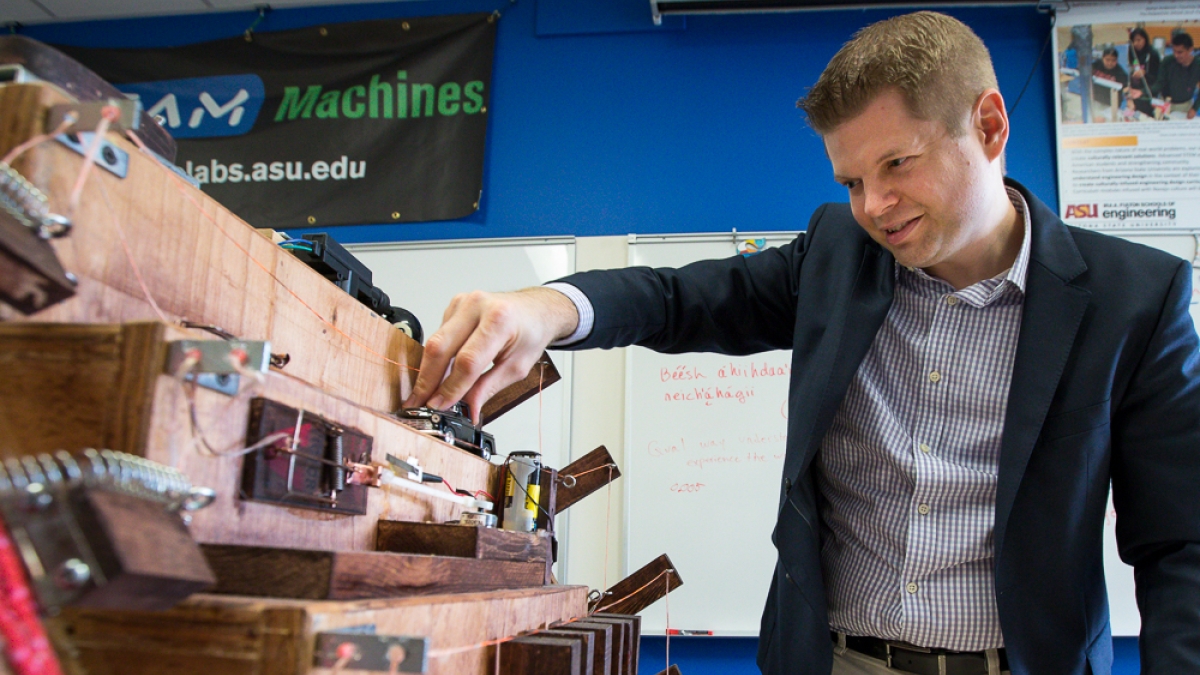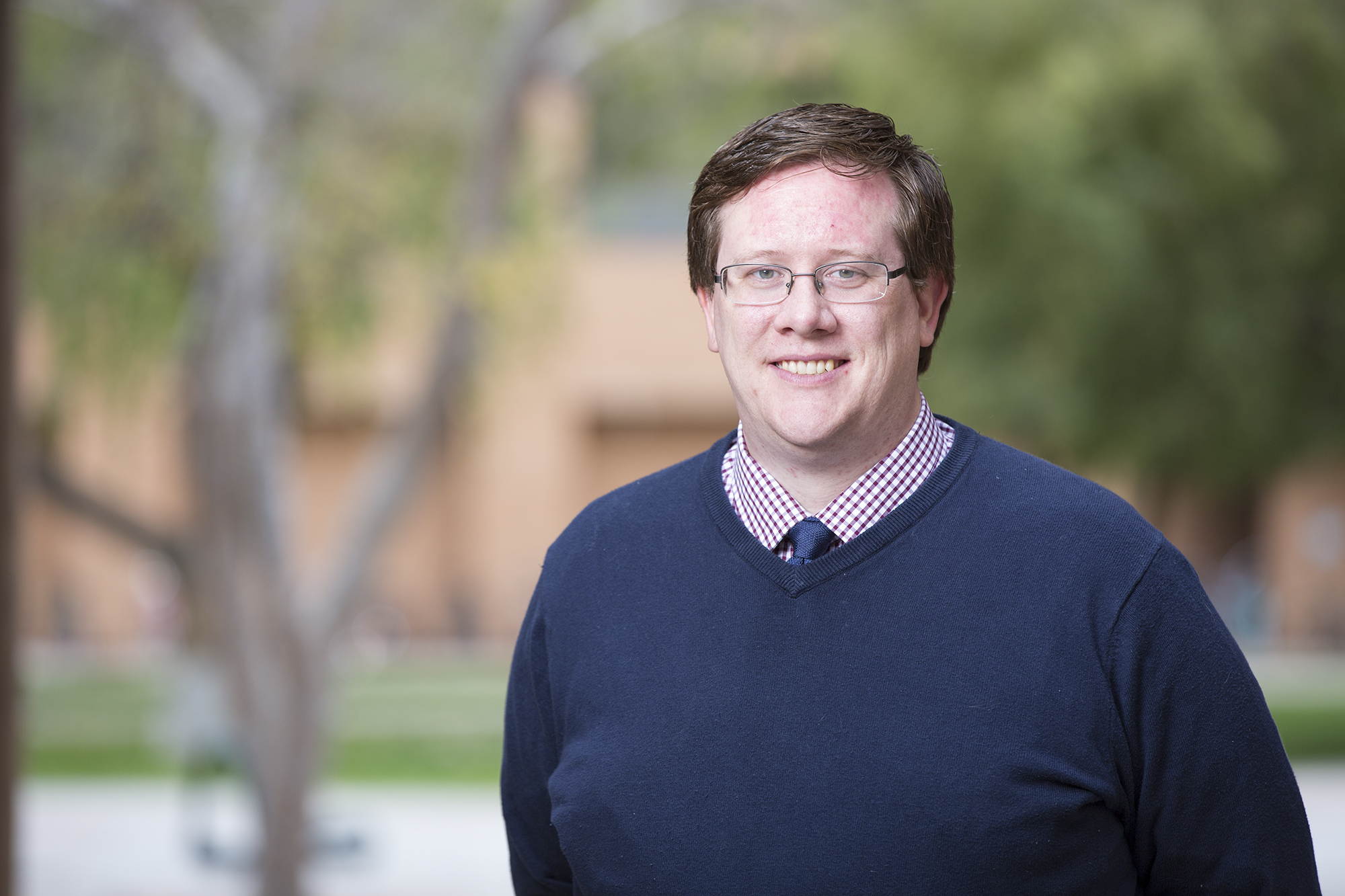You’ve got a candle to extinguish. You could blow it out, or you could flick a domino that clicks into a mouse trap, which slaps a board, knocking a bowling ball down a chute, where it rolls into a bucket, spilling water that douses a candle.
That latter series is a Rube Goldberg solution, and an ASU researcher has leveraged the concept to get Navajo middle schoolers interested in engineering.
For his ingenuity, 38-year-old Shawn Jordan, an assistant professor in the Ira A. Fulton Schools of Engineering, has been honored by the White House as the winner of a Presidential Early Career Award for Scientists and Engineers. He was one of two Fulton teachers so recognized recently, among about 100 educators across the nation.
“These innovators are working to help keep the United States on the cutting edge,” President Barack Obama said in a statement, announcing the award. He added that their work shows “that federal investments in science lead to advancements that expand our knowledge” and “contribute to our economy.”
Jordan’s curriculum teaches engineering design together with Navajo culture to show students opportunities in science, tech, engineering and math. It “has the potential to inspire thousands of Navajo students to pursue careers in engineering and have a positive impact on the Navajo Nation,” he said, adding that the award was a surprise that left him “both humbled and honored.”
It’s the latest for Jordan, who at one point held the Guinness World Record for the longest working Goldberg contraption, a 125-step masterpiece of chain reactions. He has appeared on “Modern Marvels” and “Jimmy Kimmel Live!” and he worked on the PBS show “Design Squad.”
His work could improve diversity in STEM fields. The National Science Foundation reported that only 0.6 percent of all students enrolled in undergrad engineering programs from 2000-2009, the latest numbers available, were American Indian.
“Navajo students are hands-on learners and have been doing this type work in their everyday lives, but didn’t realize it was engineering,” said Kalvin White, administrator for the Navajo Nation Department of Dine Education. “When they realize engineering can give them an opportunity to be creative while helping their community and family needs, they see it as a real benefit.”
Assistant professor Kory Hedman works to improve energy transmission in the power grid. Photo by Deanna Dent/ASU Now
Meanwhile, 35-year-old Kory Hedman, another Fulton assistant professor, also received presidential recognition. Hedman works in electrical engineering and has been involved with the Power Systems Engineering Research Center, which focuses on integrating renewable energy into the power grid.
“Transfer limits in the power grid can prevent the use of clean, renewable energy from remote locations,” Hedman said. “While building new transmission infrascructure is a possible solution, new transmission is expensive and often comes with a great pushback based on a 'not in my backyard' philosophy.”
Hedman and a team of researchers developed optimization models and algorithms that harness the flexibility in existing transmission hardware to re-route electrical power around transmission bottlenecks.
In 2015, PJM Interconnection LLC, an electric transmission system serving 13 states and the District of Columbia, announced they would seek proposals to develop and implement his technology, estimating a savings of at least $100 million a year.
“Recognition at this level speaks very highly of the talent within the Fulton Schools and the transformative ideas and impacts produced by our faculty,” Fulton Dean Kyle Squires said. “The PECASE awards for Kory and Shawn are an incredible validation of the quality of their scholarship and effectiveness at advancing their ideas in ways that create new knowledge and the translational impacts that ultimately improve not only the economy but our society at large and quality of life.”
More Science and technology

NASA launches space telescope to chart the sky and millions of galaxies
California’s Vandenberg Space Force Base was the site for Tuesday’s 8:10 p.m. launch of the NASA SPHEREx mission aboard a SpaceX Falcon 9 rocket.The SPHEREx (Spectro-Photometer for the History of the…

ASU-led Southwest Sustainability Innovation Engine funds 8 promising tech startups
In the startup world, tech companies often fall victim to what’s known as the “valley of death” — the gap between technological proof of concept and actual viable product.Aiming to bridge this…

New study explores the link between diet, blood sugar and cancer risk across species
Researchers have long known that diet exerts a profound influence on health, including the risk of developing cancer. A new study, led by researchers at Arizona State University, explores the…



